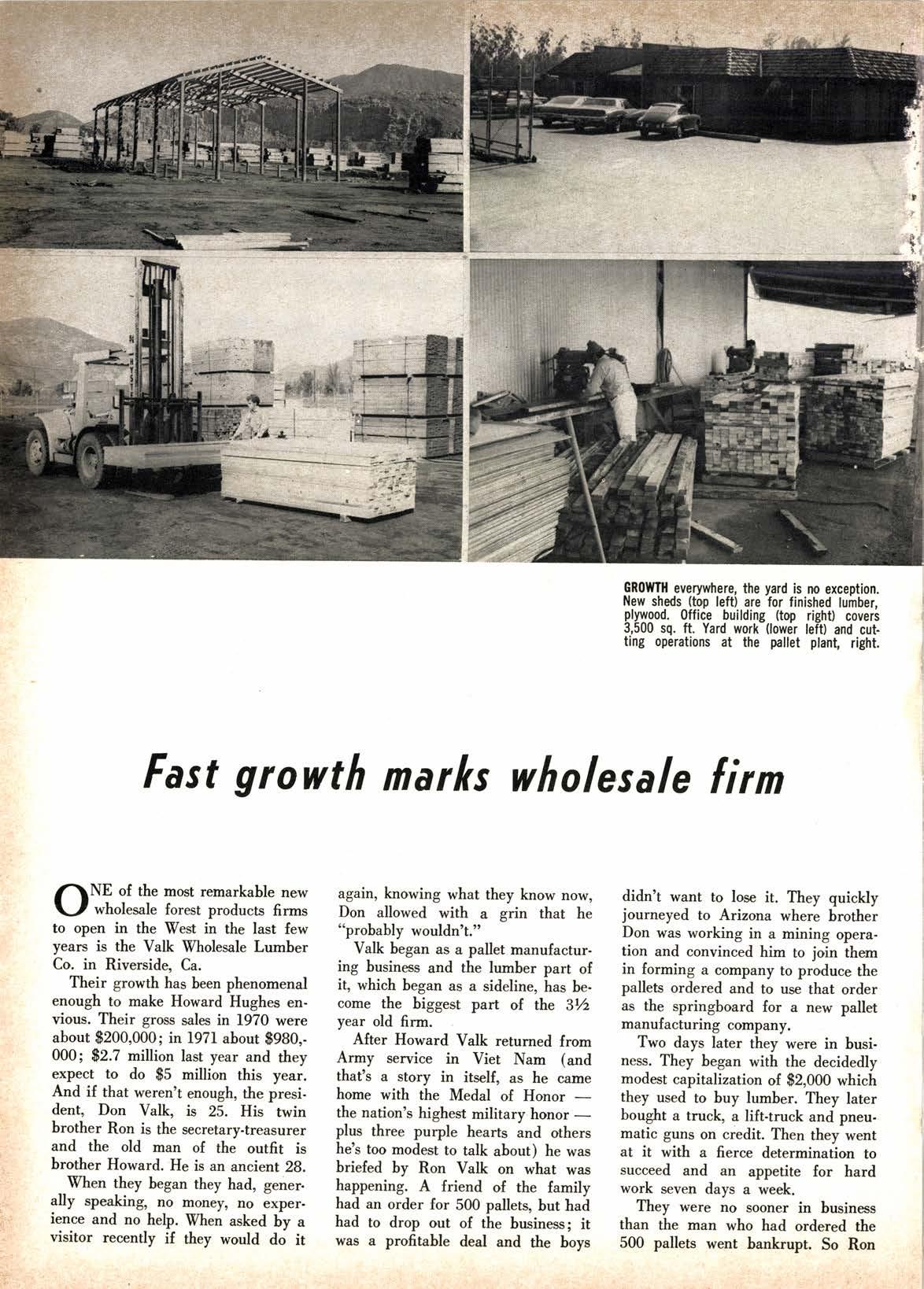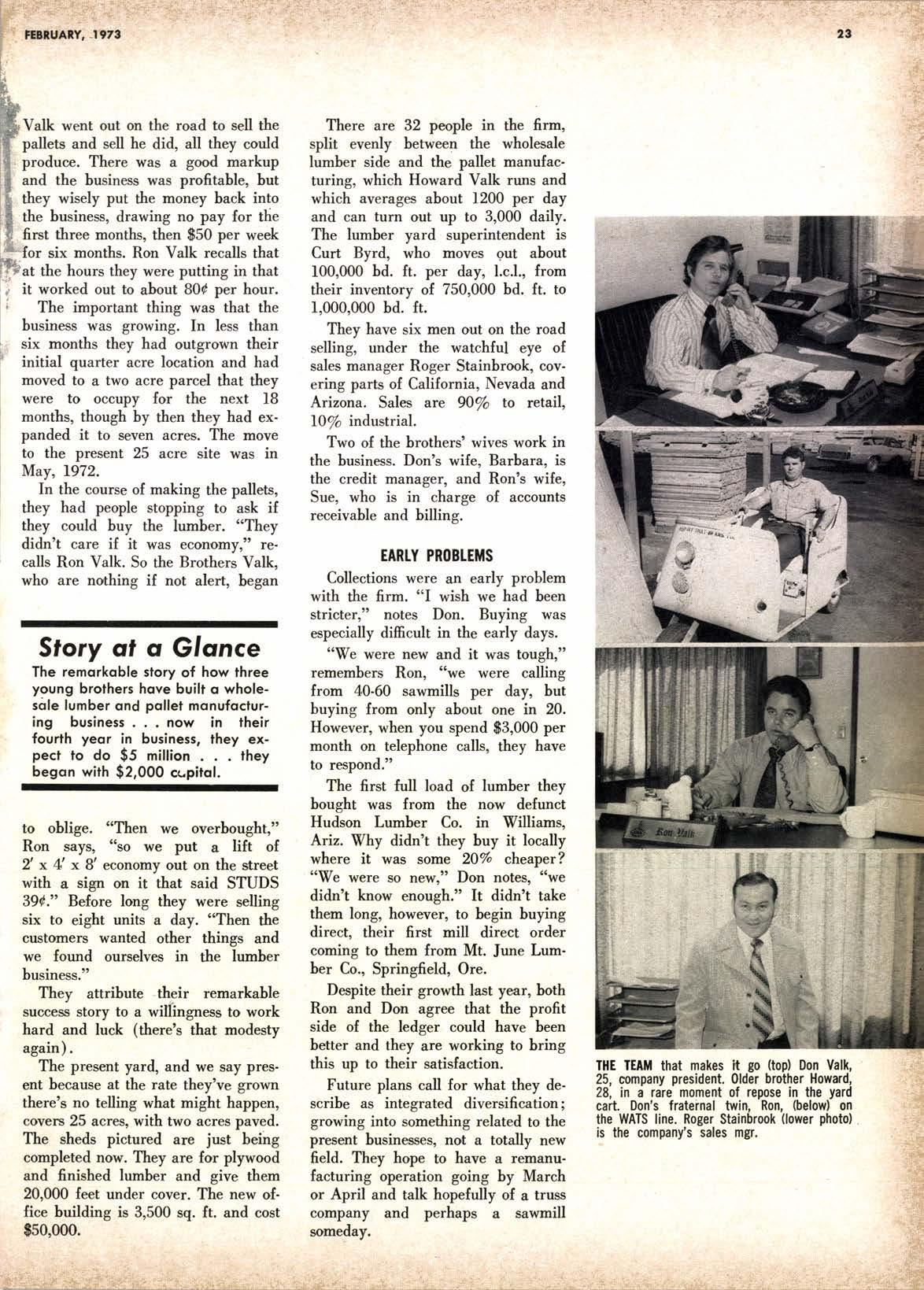
5 minute read
Fast growth narks wholesale firm
1/-lNE of the most rernarkable new \-rf wholesale forest products firms to open in the West in the last few years is the Valk Wholesale Lumber Co. in Riverside, Ca.
Their growth has been phenomenal enough to make Howard Hughes envious. Their gross sales in 1970 were about $200,000; in l97I about 9980,000; $2.7 million last year and they expect to do $5 million this year. And if that weren't enough, the president, Don Valk. is 25. His twin brother Ron is the secretarv-treasurer and the old man of the outfit is brother Howard. He is an ancient 28. When they began they had, gener. ally speaking, no money, no experience and no help. When asked by a visitor recently if they would do it again, knowing what they know now, Don allowed with a erin that he "probably wouldn't."
Valk began as a pallet manufactur. ing busines and the lumber part of it, which began as a sideline, has become the biggest part of the 3r/z year old firm.
After Howard Valk returned from Army service in Viet Nam (attd that's a story in itself, as he came home with the Medal of Honor - the nation's highest military honor - plus three p"rpl" hearts and others he's too modest to talk about) he was briefed by Ron Valk on what was happening. A friend of the family had an order for 500 pallets, but had had to drop out of the business; it was a profitable deal and the boys didn't want to lose it. They quickly journeyed to Arizona where brot-her Don was working in a mining operation and convinced him to join them in forming a company to produce the pallets ordered and to use that order as the springboard for a new pallet manufacturing company.
Two days later they were in busi. ness. They began with the decidedly modest capitalization of $2,000 which they used to buy lumber. They later bought a truck, a lift-truck and pneumatic guns on credit. Then they went at it with a fierce determination to succeed and an appetite for hard work seven days a week.
They were no sooner in business than the man who had ordered the 500 pallets went bankrupt. So Ron
Valk went out on the road to sell the pallets and sell he did, all they could , produce. There was a good markup and the business was profitable, but they wisely put the money back into the business, drawing no pay for the first tlrree months, then $50 per week six months. Ron Valk recalls that at the hours they were putting in that it worked out to about 80d per hour.
The important thing was that the business was growing. In less than six months they had outgrown their initial quarter acre location and had moved to a two acre parcel that they were to occupy for the next l8 months, though by then they had expanded it to seven acres. The move to the present 25 acre site was in May, L972.
In the course of making the pallets, they had people stopping to ask if they could buy the lumber. "They didn't care if it was economy," re. calls Ron Valk. So the Brothers Valk, who are nothing if not alert, began
Slory ol s Glonce
The remqrkoble story of how three young brothers hove built o wholesirle lumber ond pollet monufocluring business . . . now in their fourth yeor in business, they expect to do $5 million . they begon wirh $2,000 cqpitql.
to oblige. "Then we overbought,'n Ron sIS, toso we put a lift of 2' x 4 x 8'economy out on the street with a sign on it that said STUDS 39d." Before long they were selling six to eight units a day. "Then the customers wanted other things and we found ourselv€s in the lrrmber business."
Thev attribute their remarkable ,o*"* story to a wifingrress to work hard and luck (tlere's that modesty again).
The present yard, and we say present because at the rate they've grown there's no telling what might happen, covers 25 acres, with two acres paved. The sheds pictured are just being completed now. They are for plywood and finished lumber and give them 20,000 feet under cover. The new office building is 3,5fi) sq. ft. and cost s50,000.
There are 32 poople in the firm, split evenly between the wholesale lumber side and the pallet manufacturing, which Howard Valk runs and which average about 1200 per day and can turn out up to 3,000 daily. The lumber yard superintendent is Curt Byrd, who moves o. ut about 100,000 bd. ft. per day, l.c.l., from their inventory of 750,000 bd. It. to 1,000,000 bd. ft.
They have six men out on the road selling, under the watchful eye of sales manager Roger Stainbrook, covering parts of California, Nevada and Arizona. Sales are 9O/o to retarl, 107o industrial.
Two of the brothers' wives work in the business. Don's wife, Barbara, is the credit manager, and Ron's wife, Sue, who is in charge of accounts receivable and billing.
EARTY PROBTE}IS
Collections were an early problem with the firm. "I wish we had been stricter," notes Don. Buying was especially difficult in the early days. ttWe were new and it was tough," remembers Ron, "we were calling from 40-60 sawmills per day, but buying from only about one in 20. However, when you spend $3,000 per month on telephone callso they have to respond."

The first full load of lumber they bought was from the now defunct Hudson Lumber Co. in Williams, Ariz. Why didn't they buy it locally where it was some 20/o cheaper? "We were so newrt' Don notes, ttwe didn't know enough." It didn't take them long, howwer, to begin buying direct, their first mill direct order coming to them from Mt. June Lumber Co.o Springfeld, Ore.
Despite their growth l'ast year, both Ron and Don agree that the profit side of the ledger could have been better and they are working to bring this up to their satisfaction.
Future plans call for what they describe as integrated diversification; growing into something related to the pres€nt businesses, not a totally new field. They hope to have a remanufacturing operation going by March or April and talk hopefully of a truss company and perhaps a sawmill someday.
Msnvlaclurers of Quofity Forest Producfs
Leogths up to l8'. Fioe grained old growth timber from our Yolla Bolla Tree Farm,
Douglas Fir, White Fir, lncense Gedar, Sugar Pine, Ponderosa Pine lnterstate 5 Freeway comes practically to our door. FAST shipment is made easy by our location.
Why take a chance on a transit car from Brand X or Brand ?
Next time ask your favorite wholesaler to try Crane Mills first.
U,P. lmprovemenl Progrom
Union Pacific Corp. plans a capital ixpenditure program for 1973 of $I95 million, up $40 million from tlre estimated $155 million invested in 1972, according to Frank E. Barnett, chairman of the board and chief executive officer.

'oThe majority of the funds, gl20 million, will be earmarked for the purchase of new equipment and roadway improvements for the Union Pacific Railroad," Barnett said. This is an increase of $5 million.
The remaining $75 million will be spent on expanding and improving Union Pacific's two other major areas of operation, natural resources and land development.
The road's 1973 rolling stock program ".11. for the acquisition of 60 new 3000 h.p. locomotives and 2,150 new freight cars. The order includes 300 box cars of various sizes and capacities, 500 insulated box cars of 70-ton capacity, 300 open-top hopper ears of l0O.ton capacity and 400 covered hopper cars of 100+on capacity, 600 70-ton box cars and 50 flat cars.










